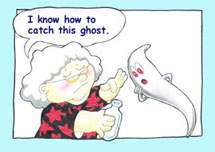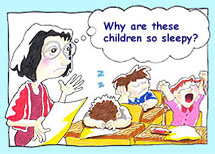Grammar: Sentence: Quoting and reporting speech and thoughts
| Quoting speech and thoughts |
Saying and thinking verbs in direct speech
The most common verb used to quote speech is say, and to quote thoughts is think. These verbs are very general in meaning and can be used to quote not only statements but also questions and commands, both spoken and thought.
Saying verbs for quoting statements
The verbs say and tell are the most common verbs used to quote spoken statements. When we use the verb say we can choose whether or not we state who is being spoken to. However, when we use the verb tell we must always include the person spoken to, ie the 'Receiver':
|
"Oh don't be so silly!" Granny said. "Oh don't be so silly!" Granny said
to the ghost. "Oh don't be so silly!" Granny
told the ghost. |
|
Note that the 'Receiver', ie the one to whom the statement is addressed, is expressed in a noun group with the verb tell (told the ghost), but in a prepositional phrase with the verb say (said to the ghost).
Note also that the 'Sayer', ie the one who is speaking, is always named. However, the Sayer does not have to be a human being. It is quite common to attribute speech and even thoughts to animals (my dog thinks we're going out) and things (my computer is telling me to save this file, the clock says it's only three).
In writing we use a much greater variety of saying verbs than in conversation, eg announce, observe, point out, remark, report.
Saying verbs for quoting questions, offers and commands
When the quoted clause is not a statement but a question, offer or command, we often use verbs that are more specific than say to introduce the quotation.
Questions can be quoted with verbs such as ask, demand, inquire, query:
| "But GrumpyGhost, did you come through the door?" Granny Gong asked. |  |
Commands and offers can be quoted with verbs such as call, decide, demand,
offer, order, propose, request, suggest, tell:
| "I want you to get me some clean water to drink!" MegaMonster ordered. |  |
| "We want our water back!" demanded the children. |  |
Thinking verbs for quoting statements, questions and commands
The verb think is the most common verb used to quote thoughts, with little difference between statements, questions, offers and commands:
| Granny thought, "I know how to catch this ghost." |
 |
| "Why are these children so sleepy?" Miss Lee thought. |
 |
While we cannot address our thoughts to someone else (unlike our speech), and so cannot have a third-party Receiver, speakers commonly quote their thoughts as being addressed to themselves:
| "We'll catch you yet" Granny thought
to herself. Sayer Receiver |
The Receiver following the verb think (as with the verb say)
is expressed in a prepositional
phrase with to. However, whereas the Head of the prepositional
phrase following say can be a noun, the Head of the prepositional phrase following think must be a
reflexive pronoun (myself, yourself, herself, himself, ourselves, yourselves,
themselves)
![]() .
.
In writing we find a few other verbs of thinking used for direct speech, eg reflect, surmise, wonder:
| "How did he get in here?" Granny wondered. |
Whereas think is most commonly used for quoting thoughts, ie in direct speech, other verbs are quite common when reporting thoughts, ie in indirect speech.
Saying verbs used for dialogue in narrative
Direct speech is very common in stories, where it is used to create a dialogue involving the main characters. Using direct speech in this way gives the story a greater sense of realism and drama. Verbs such as ask, answer, reply, respond etc are often used to show what role the speakers are playing in the dialogue as well as lending colour to what they're saying. A good example comes from the story Granny Gong and the GrumpyGhost:
|
|
"GrumpyGhost," she said. "How did you get into our apartment?" "Oh, very easily," replied GrumpyGhost. That wasn't the answer that Granny wanted, so she asked: "But GrumpyGhost, did you come through the door?" "Of course not!" exclaimed the ghost crossly. "I came through the keyhole." "Oh don't be so silly!" cried Granny. "That's impossible! You must be joking!" |
In written dialogue it is very common to find the following deviations from the basic pattern: a quoting clause followed by several quoted clauses or no quoting clause at all. The Granny Gong story provides an example of both:
| "Oh don't be so silly!" cried Granny. "That's impossible! You must be joking!" |
Here That's impossible! is not formally introduced by a quoting clause, and You must be joking! simply follows on the former clause in direct speech. However, we know from the context that both clauses are quotations of what Granny said, ie both are quoted clauses.
Saying verbs used to show the manner in which
something was said
Many quoting verbs can be used to indicate the manner in which words were spoken. Such verbs, eg boast, complain, cry, exclaim, grumble, insist, murmur, shout, stammer, whisper, yell, are common in story writing but not usually found in speech. Here are some examples from the Gong Family stories:
| SleepStealer whispered in Kitty's
ear: "Don't stop yet! Just one more game!" "Aha! Of course!" cried MegaMonster. "There's the water thief!" the children shouted. "Hooray for Granny Gong!" yelled the children as they jumped into the pools. |
An alternative to using such expressive verbs is to combine a simple say with an adverb of manner, eg she said loudly.
Some expressive verbs are used to quote speech as well as thoughts, eg dream, ponder, puzzle, wonder.
| "Whatever will they think of next?" Mrs Gong wondered. |
| For information about some of the problems that students have with the use of saying verbs in direct speech, click here: |  |
For more information on adverbs of manner, see
![]() Grammar:
Word classes: Adverbs: Expressing how / when / where
Grammar:
Word classes: Adverbs: Expressing how / when / where
Note that the terms Sayer and Receiver are written with an initial capital to remind us that they are functional terms.
|
Alternative terms |
|
| PrimeGram | Other grammars |
| clause | simple sentence |
| clause complex | sentence, compound sentence, complex sentence |
Tell me more ... Structure of direct speech |
|
||
To give us feedback about this section, click here or on the Comment button at the top of the screen.
If you have any questions about this section, visit the Language Corner.
If you have any questions or suggestions about how to teach this section, send a message to the Teaching Corner.